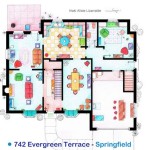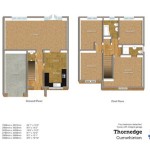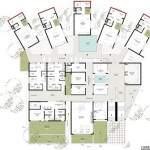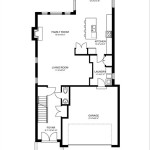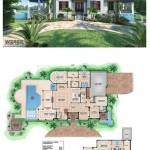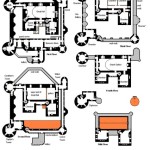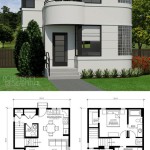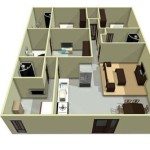Colonial House Plans with Garage Under
Colonial-style homes evoke a sense of timeless elegance and historical charm. Pairing this classic architectural style with the practicality of a garage under the house presents a compelling option for homeowners seeking both aesthetic appeal and functional living space. This article explores the key aspects of colonial house plans incorporating under-house garages.
Advantages of a Garage Under
Positioning the garage beneath the main living area offers several distinct advantages. This design maximizes land usage, particularly beneficial on smaller lots or sloped terrains. It also creates a more streamlined exterior appearance, allowing the colonial facade to take center stage. Incorporating the garage underneath can reduce construction costs compared to building a detached garage, as it shares a foundation with the house. Finally, direct access from the garage to the home provides convenience and added security, especially during inclement weather.
Design Considerations for Colonial Homes with Under-House Garages
Careful planning is essential to seamlessly integrate an under-house garage with a colonial home's aesthetic. The garage doors should complement the overall design, avoiding visually jarring elements. Consider using carriage-style doors or painting them a color that harmonizes with the home's exterior. Landscaping plays a crucial role in softening the appearance of the garage and integrating it into the surroundings. Strategic placement of shrubs, trees, and flowerbeds can effectively camouflage the garage entrance and enhance curb appeal.
Foundation and Structural Requirements
Building a garage under the house necessitates a robust foundation capable of supporting the weight of both structures. This typically involves a concrete slab or foundation walls. Proper drainage is paramount to prevent moisture issues in the garage and living areas above. Effective waterproofing and ventilation systems must be implemented to mitigate moisture-related problems. The garage floor should be sloped appropriately for drainage and sealed to prevent water penetration. Consider the local climate and soil conditions when designing the foundation and drainage systems.
Maximizing Space and Functionality
Thoughtful space planning is essential for maximizing the functionality of both the garage and the living spaces above. Consider the number of vehicles to be accommodated, storage needs, and potential future uses. Ensure adequate ceiling height in the garage to accommodate larger vehicles and overhead storage. Incorporate built-in storage solutions, such as shelving and cabinets, to efficiently utilize the available space.
Interior Design Considerations
The interior layout of a colonial home with an under-house garage presents unique design opportunities. The entryway from the garage to the home can be designed as a functional mudroom or utility area. This space can incorporate storage for coats, shoes, and other outdoor gear, helping keep the main living areas tidy. Consider the placement of stairs leading from the garage to the upper levels, ensuring they are conveniently located and integrated seamlessly into the floor plan.
Exterior Style and Curb Appeal
Maintaining the architectural integrity of the colonial style is paramount when designing a house with an under-house garage. Choose exterior materials and finishes that complement the colonial aesthetic, such as brick, siding, or wood. Pay attention to details like window styles, shutters, and trim work to ensure a cohesive and historically appropriate look. Landscaping should be designed to enhance the overall curb appeal, creating a welcoming and attractive entrance to the home.
Cost Considerations
Building a colonial home with a garage under can present both cost savings and potential additional expenses compared to a detached garage. Savings may be realized through shared foundation costs and reduced exterior wall construction. However, factors such as excavation, drainage systems, and structural reinforcement can add to the overall budget. Conduct a thorough cost analysis, considering site-specific conditions, material choices, and local labor rates, to accurately estimate the project budget.
Planning and Zoning Regulations
Before embarking on any construction project, thoroughly research local zoning regulations and building codes. These regulations dictate setbacks, height restrictions, and other requirements that may impact the design and feasibility of an under-house garage. Obtain necessary permits and approvals from local authorities before commencing construction. Working with an experienced architect and builder familiar with local regulations can streamline the permitting process and ensure compliance with all applicable codes.
Accessibility and Future Adaptations
Consider incorporating accessibility features into the design, such as wider doorways, ramps, and elevators, to accommodate future needs. This forward-thinking approach can enhance the long-term value and usability of the home. Designing the garage and interior spaces with flexibility in mind allows for future adaptations, such as converting the garage into additional living space or adding an accessory dwelling unit.

2200 Sq Ft Colonial With Two Car Garage Under 2 House Plans

Colonial Style House Plan 3 Beds 2 5 Baths 1790 Sq Ft 1029 54 Dreamhomesource Com

Colonial House Plan 4 Bedrms 3 Baths 2097 Sq Ft 109 1057

House Plan 24753 Colonial Style With 2159 Sq Ft 3 Bed 2 Bath

Colonial House Plans Traditional Designs Drummond

House Plan 2559 00907 Colonial 2 400 Square Feet 4 Bedrooms 3 5 Bathrooms Plans Dream

Colonial House Plan 10115 Cl Home Designing Service Ltd

Colonial Style House Plan 6 Beds 5 Baths 6858 Sq Ft 932 1 Houseplans Com

Colonial Style House Plan 4 Beds 3 5 Baths 2400 Sq Ft 48 648 Houseplans Com

Colonial House Plan With 4 Bedrooms And 2 5 Baths 4338

